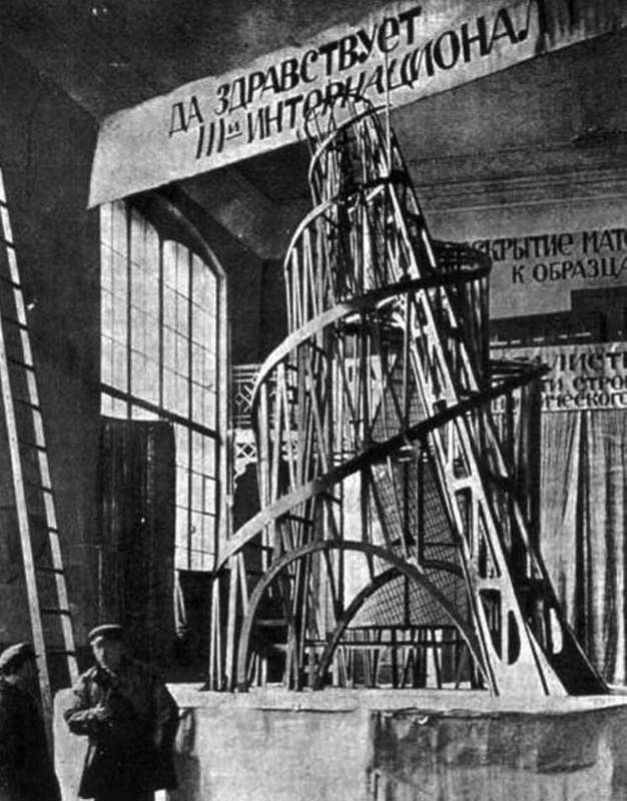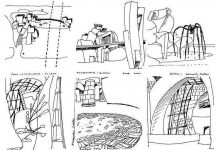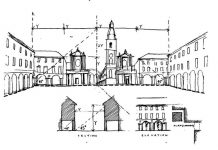The Russian constructivist movement flourished briefly in the 1920s and 30s. Constructivist architects produced breathtaking modern designs, often glorying in unusual and innovative structures. Although not all of these structures were actually built, they had a huge influence on architects not only in the Soviet Union, but elsewhere in Europe, too.
There are some artistic movements that, although short-lived and confined to one particular place, punch above their weight in terms of their influence. One example is constructivism, a movement that developed in Russia in the 1920s and 30s, spawned a handful of famous and innovative buildings and was eliminated as a result of changing Soviet artistic policy. But its influence lived on in the work of a constructivist group in Switzerland called ABC and in the work of the Bauhaus (see Bauhaus), and still inspires architects today.
Revolutionary beginnings
Constructivism grew out of two things—an artistic avant garde that was already flourishing and asking challenging questions about art and design before the 1917 revolution and the feeling that the new post-revolutionary communist society needed new ways of looking at art and making buildings. Constructivism was not the only artistic movement that grew out of these ideas, but it was among the most important—especially for architecture.
“Down with guarding the traditions of art. Long live the Constructivist technician.” Constructivist slogan
The first great constructivist design was also the most famous. It was the Monument to the Third International designed by artist and architect Vladimir Tatlin, an extraordinary invention that only ever existed as a large model, but which if built would have been one of the most bizarre and striking structures in the world. The monument, now widely known as Tatlin’s tower, was intended to be 400 meters (1,300 ft) tall and to stand over the River Neva in Petrograd (St. Petersburg). It was to consist of a vast double spiral of girders, leaning to one side and tapering toward the top. Inside this openwork cat’s cradle of metalwork was a number of suspended revolving glass rooms designed as perfect forms—a cube, a pyramid and a cylinder.
OSA
Constructivist architecture was very varied, but there were two main groupings of architects, each with its own society and defined set of views. The first was the Society of Contemporary Architects (OSA). It was led by Moisei Ginzburg and was strongly influenced by architectural developments in the West, especially by the functionalist ideas of the likes of Le Corbusier. They saw it as important in a workers’ society for aesthetics to be drawn from the factory—both in terms of the functional design of factory buildings and in the appearance of mass-produced objects. OSA architects did a lot of work on the design of mass housing, basing their plans on the everyday requirements of the occupants—small bedrooms and bathrooms and larger living rooms, for example. Their buildings had many of the features common in western modernism, such as the use of long strip windows and raising building on pilotis (columns).
Constructivist interests
Tatlin’s tower (see below) combined a frank display of structure, a use of modern materials, an interest in pure geometry and an enthusiasm for unconventional and distorted structures, all features that fascinated the constructivists. Similar interests inspired similarly unlikely projects such as a design for a Lenin Tribune—a leaning openwork tower—by El Lissitsky, a designer now more famous as a spare and elegant abstract artist. More ostensibly practical, but equally daring, were Lissitsky’s “Cloud-hangers,” towers capped with vast “horizontal skyscrapers.” None of these was ever built, but they inspired architects looking for new ways to use materials such as steel, concrete and glass.

The constructivist projects that actually were built included Konstantin Melnikov’s Rusakov Workers’ Club in Moscow, which combines odd angles and forms with modernist white walls; the Zuev Workers’ Club, with its glass tower; and Melnikov’s own house in Moscow, again with a tower. Buildings such as these, more outré and experimental than anything being built in western Europe at the time, put Soviet Russia into the vanguard of architecture. Their designers and advocates felt that, like the abstract art that was being produced at the same time, their work represented a radical new outlook, quite appropriate for the new social system being formed under communism.
“Construction is organization.” Vladimir Tatlin
Opponents and influences
Not everyone in Russia agreed. Against those who saw the importance of new art for the new social order were those who saw the groups of artists and architects flourishing at this time as elitist and irrelevant to the people as a whole. And so, in 1932, the proliferation of artistic groups was suppressed by the Russian leadership. Russian architecture turned away from modernism, futurism, constructivism and all the other -isms, and embraced a conservative, neo-Renaissance norm.
ASNOVA
The members of the Association of New Architecture (ASNOVA) described themselves as rationalists rather than constructivists, but they shared many of the ideas of the constructivist movement. While stressing the scientific basis of modern architecture, they also wanted their buildings to make bold, heroic gestures to inspire the people to embrace revolutionary values. The unusual structures and theatrical appearance of many ASNOVA buildings were often criticized as indulgent by the more restrained members of OSA.
Some of the Russian modernists and constructivists moved to the West. El Lissitsky, for example, went to Switzerland, where he was one of the founders of the constructivist group ABC. Through this group some of the ideas of the constructivists came to the attention of other European design groups, such as the Bauhaus. Their individual take on modernism is perhaps reflected in the much later work of the deconstructivist architects of the late 20th century (see Deconstructivism), who combined ideas such as the display of structure and the use of unusual angles and forms to new and provocative effect.



















